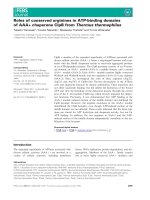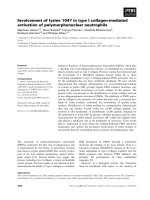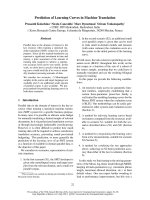Báo cáo khoa học: "REPRESENTATION OF FEATURE SYSTEMS IN A NON-CONNECTIONIST MOLECULAR MACHINE" pptx
Bạn đang xem bản rút gọn của tài liệu. Xem và tải ngay bản đầy đủ của tài liệu tại đây (243.29 KB, 4 trang )
REPRESENTATION OF FEATURE SYSTEMS IN A NON-CONNECTIONIST
MOLECULAR MACHINE
L~zI6 K6im~n
Institute of Linguistics
Hungarian Academy of Sciences
Budapest I., P.O.Box 19.
H-1250 HUNGARY
ABSTRACT
This paper is part of an enterprise
whose aim is to represent linguistic
knowledge in the form of a molecular
machine (a dynamic network). That is, the
molecules of the network not only store,
but also send, receive, and process
information. It is claimed that such a
network can be conceived of as a model of
the coalition structure of a
connectionist network. The paper
describes how the class of feature
systems called unary feature hierarchies
(whose importance is supported by
phonological theory but will not be
argued for in the paper) can be
represented in the molecular machine.
INTRODUCTION
Of the various branches of modern
linguistic theory, phonology, as usual,
was the first one to come up with really
restrictive theories of features and
feature systems, largely supported by
empirical evidence coming from the study
of a legion of linguistic phenomena.
Phonology will most probably remain main
source of evidence as far as the
functioning of feature-based cognitive
processes is concerned.
The present paper sets out to outline
how a particular kind of feature system,
close to several recent theories of
phonological features, can be represented
in connectionist networks. However, since
some of the mechanisms involved,
seriality and synchronization in
particular, fall outside the scope of the
existing connectionist networks, a non-
connectionist model simulating would-be
serial connectionist networks will be
used instead. The automaton described in
the paper is able to unify feature
structures as programs to be run on the
machine itself.
UNARY FEATURE HIERARCHIES
The feature systems under scrutiny
can be termed unary feature hierarchies.
The underlying concept is close to the
'feature geometry' approach to
autosegmental phonology (Clements 1985)
in that a feature specification consists
of features appearing on tiers, and
features on adjacent tiers can be linked
by association ~ines. Tiers are ordered
in a multi-dimensional space, and the set
of features that may appear on a
particular tier is predefined. Unarity,
on the other hand, means that a feature
either appears within a given 'span' (of
time) or it does not (instead of having
different values); the absence of a
feature simply means lack of information
or undersDecification. Features can only
be linked to specified slots; on the
other hand, tiers are adjacent to
features rather than to tiers (hence the
use of hierarchv instead of qeometry);
that is, the following configuration may
be ruled out if the H tier is adjacent to
F but not to G:
F/G tier F G
l
I
H tier H H
Figure I. This configuration may be ruled
out.
Unarity is opposed to traditional
binary feature systems (with a marked '+'
and an unmarked '-' value for each
feature) and to ternary systems (with a
marked '+', an unmarked '-', and an
unspecified '0' value), while feature
geometries (and hierarchies) replace the
old-fashioned 'feature bundle'
conception, in which each segment
consisted of an unordered set of feature-
-value pairs. Compare the following
(sketchy) representations of lax vowels
in English:
298
Features Segments
e~i A o D u
Low - + - - - + -
High - - + - - - +
Back - - - + + + +
Round + + +
Figure 2. English lax vowels as feature
bundles.
Tiers Segments
e~ziAo9 u
Root tier x x x x x x x
I I I I I I
H/L/B tier L H B B B B
I I I
R tier R R R
I I
H/L tier L H
Figure 3. Unary feature hierarchy for
English lax vowels.
That is, in this approach, feature
hierarchies not only express universal
restrictions on feature structures (as
feature geometries do, cf. Clements
1985), but language specific redundancy
rules and feature co-occurrence
restrictions as well. In addition to the
above, we shall assume the possibility of
forbidding that a feature (or, rather,
any feature of a given tier) be linked to
another. Link prohibitions are not
intended to be a feature value, hence the
below representations
a. b.
Tier 1 F F
X
Tier 2
Figure 4. Configurations with and without
link prohibition.
specify identical elements, in spite of
the fact that no feature can be linked to
F in Figure 4a. (X stands for link
prohibition.) For example, consider the
following feature hierarchy,
characterizing a language where plural
and dual nouns usually behave in the same
way (e.g. Hebrew):
1 2 3 4 5
Category tier N N N N
N
I x I
I
Number tier NSg
NSg NSg
I x
Dual tier -D
i: singular noun
2: plural noun
3: sinaulare tantum
4: dual noun and duale tantum
5: plurale tantum
Figure 5. Sample feature system.
In terms of the above, the features of
plural nouns and Dluralia tantum are
identical, in spite of the link
prohibition concerning the 'Non-Singular'
feature of the latter.
CONNECTIONIST MODEL OF FEATURE
SYSTEMS
Obviously, the presence of a feature
in a segment corresponds to a relatively
high activation level of a node or a
coalition of nodes in a connectionist
network. The vertical geometry of tiers
determines the possibilities of linking;
the essential function of links is to
synchronize the activation of features,
but they also express their dependency
relations. Thus association lines
corespond to the fact that the activation
of a node or coalition controls the
activation of another node or coalition.
Finally, link prohibitions can be
represented as the inhibition of
particular tiers. The adjacency of tiers
will correspond to super-coalitions, i.e.
features on adjacent tiers are features
whose activation can be synchronized at
all.
In our present knowledge, none of the
existing connectionist networks can learn
and encode the sequential activation of
nodes or coalitions of nodes, albeit the
organization of human memory is most
probably highly serialized. To overcome
this deficiency (and for other reasons as
well) we designed a molecular machine
(cf. Kalm~n and Kornai 1985) to model the
functioning of a sequential connectionist
network.
In this machine, each molecule
contains a more or less stable piece of
knowledge encoding the coalition
structure it participates in, in the form
of a layout of the surrounding network.
299
Molecules are able to send messages
to each other; a message has the same
form as the pieces of information stored
in the molecules, i.e. it is a directed
graph representing a substructure of
molecules with their dependencies. When a
molecule receives a message, it unifies
the message with its own map, and it
forwards the resulting information. The
ultimate addressees are the 'output
molecules', which can perform extra
actions when receiving a properly
addressed message. That is, the message
acts as a program that will, after some
modifications it undergoes, activate a
set of output molecules in a well-defined
order° Modifications correspond to the
effects of the rules stored in the
molecules on the path of the message.
One of the most important
characteristics of the messages sent (and
other maps) is that they may contain
missing steps, i.e. distinguished nodes
encoding lack of information concerning
the way between two nodes. Missing steps
can be eliminated by unification,
provided that the required path is
specified in the map of a processing
molecule. This mechanism corresponds to
the function of 'super-coalitions', i.e.
the synchronization and sequencing of the
activation of otherwise distinct
coalitions.
INFORMATION PROCESSING WITH
THE MOLECULAR MACHINE
The basic operation performed by the
molecular machine is a kind of
unification, differing from the
corresponding operation used in
unification-based grammars by virtue of
the differences in the feature structures
and their representations. Since the map
graphs of the molecular machine contain
no node variables, unification
essentially means the elimination of
missing steps. Missing steps encode both
alternative and conjunctive relations:
A B
V
C D
Figure 6. Sample directed graph with
missing step.
The missing step (the asterisk) in Figure
6 can only be eliminated by supplying a
path from A and B to either C or D, e.g.
by unifying the graph in Figure 6 with
the following:
A B
C
Figure 7. Sample directed graph without
missing step.
Figure 7 is also the resulting graph. Any
other unification will pr, vide a partial
solution at best.
The control function of the directed
graphs in question is due to the fact
that the addressed molecules are able to
reduce the messages they receive. For
example, in the case of the graph on
Figure 7, both molecules A and B will
remove their addresses from the top level
before forwarding the graph. The graph on
Figure 6, on the other hand, will be
unable to activate any of the addressees
because of the missing step it contains.
The unification and control functions
of the molecular machine together define
a particular conception of phonological
rule systems, which can be argued for on
independent grounds as well. Under this
approach, the function of a phonological
rule system is essentially to resolve
problems arising from morphological
processes, i.e. to fix ill-formed
representations resulting from affixation
by supplying missing features (e.g. in
vowel harmony), linking or delinking
features according to the derived context
(e.g. in voice assimilation). Note that
delinking in the present form of the
machine consists of adding an inhibitory
link leading to the feature to be
delinked.
FURTHER PLANS, IMPLEMENTATION
It is far from evident that syntactic
and semantic rule systems should carry
out operations similar to those in
phonological rules. On the other hand,
the operation of the molecular machine
are general enough to eventually
encompass syntactic and semantic
processes such as recognition and
completion of syntactic patterns,
inference making through unification,
etc. Some of these operations are
outlined in Kalman and Kornai (1985) and
Kalman (1986).
300
A small molecular machine is
implemented in Zoltan Schreter's (FPSE,
Geneva University) CNS connectionist
simulation system running on Olivetti
M24/M28 PCs. However, owing to the
capacity of the machines (and of TLC
Lisp, in which the system has been
written) the number of molecules is
extremely limited, and the performance
obtained is rather poor.
REFERENCES
Clements, George N. 1985. The
geometry of phonological features.
Phonology yearbook 2, 225-252.
Kalman, Laszl6 and Andras Kornai.
1985. A finite-state approach to
generation and parsing. Paper presented
at the Generative Grammar Fiesta,
Salzburg.
K~im~n, I~szl6. 1986. Semantic
interpretation in a dynamic knowledge
representation. Mfihelymunk~k (Working
Papers of the Institute of Linguistics)
1, No. 2,
pp. 31-51.
301









